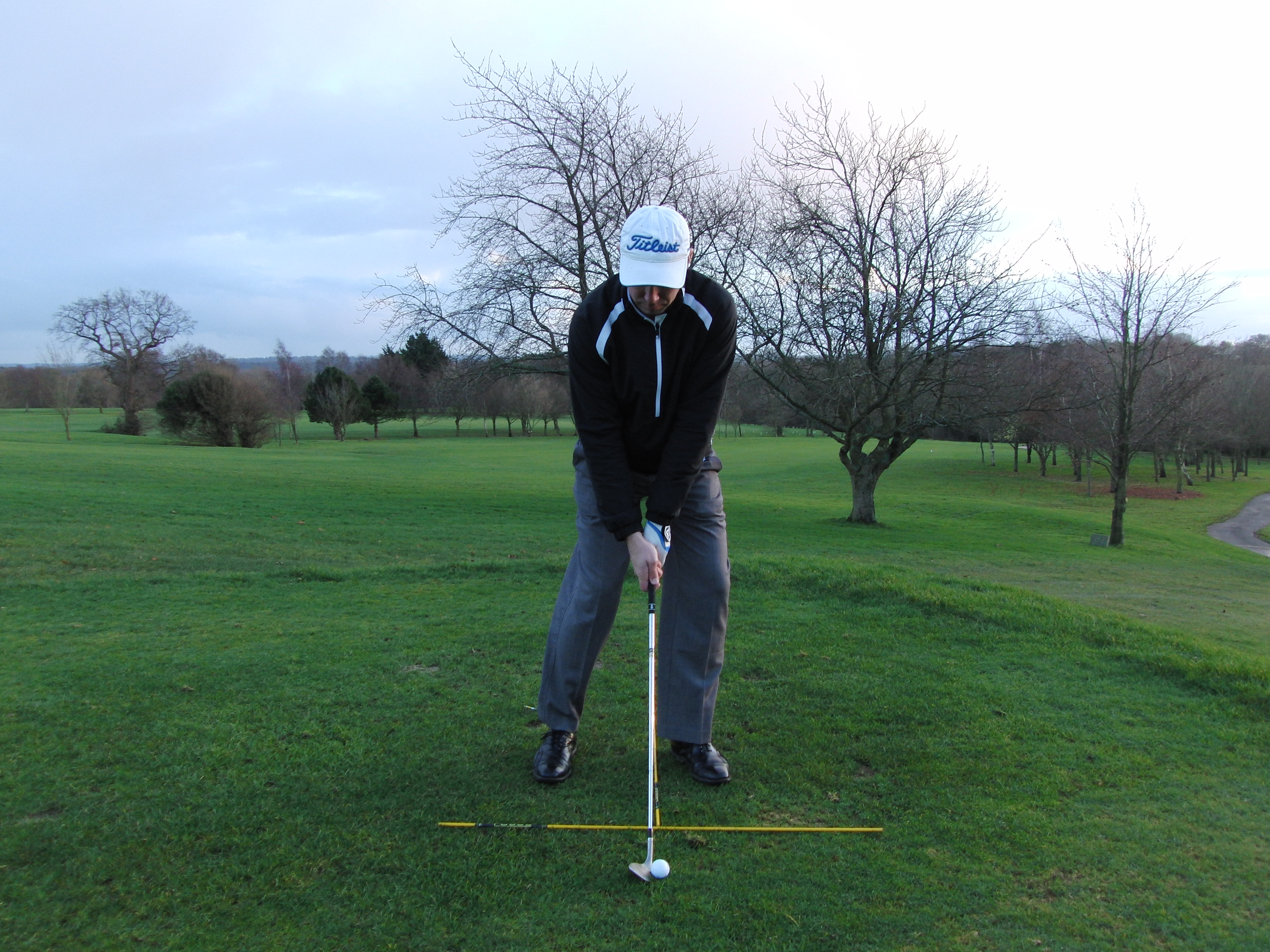How to Generate Power in the Golf Swing
Power Charge the Golf Swing
One way to generate power in the golf swing is by generating momentum. A good example here is a baseball pitcher, to throw a ball with power he winds back before he releases.
The same principles apply in the golf swing.
You need to turn around your right side in the backswing with no sway.
One of the common misconceptions of amateurs is that they have to swing really hard and fast to create a lot of power, this results in an off plane and off balance golf swing. Resulting in a lack of power and distance.
The only way to create power is to build up momentum in your swing with a good body turn.
Watch the video here and see how to create the correct body turn for the golf swing.
From Your Friends at Mark Wood Golf Academy
PS. Come down and tee it up to make some magic moments of your own. Check our website at
Mark Wood
PGA Advanced Professional
UK’s No1 Golf Coach
The Best Golf Lessons in Sussex and Kent
The First Move
The Take Away
I am always being asked what initiates the backswing. I believe and teach that the first move away from the ball is more a upper body movement than the lower body movement. If you think of your shoulders, arms and hands as a unit, these move away from the ball together. You need to feel that the lower body resists, a good way to feel this is for you to keep your belt buckle as quite as possible during the early part of the takeaway.
A great check point in the takeaway is when the shaft of the club gets parallel to the ground, and it is a major important part of your swing, other than impact. I know how important it is to make a perfect set up as this gives you a great chance in making a good solid swing. If you get any parts of the set up wrong you will have to make compensations in the golf swing. The Perfect takeaway is a must because if you get the first part of the swing wrong you are going to have to compensate else where in the swing, not a great recipe for consistency in ball striking!!
Many times when I see a golfer with a faulty takeaway, they generally have major problems in there short irons, pitching and chipping. As it has been said many times before a pitching swing is a mini version of the full swing, so it becomes very important to get the takeaway correct.
To get the club moving away from the ball correctly, you need to swing the club back along the angle of the shaft. Not inside it or outside it but on it until the club head covers your hands and the shaft is parallel to the ground.

Good Position Clubhead covering the hands and shaft parallel
to the ground and target line.
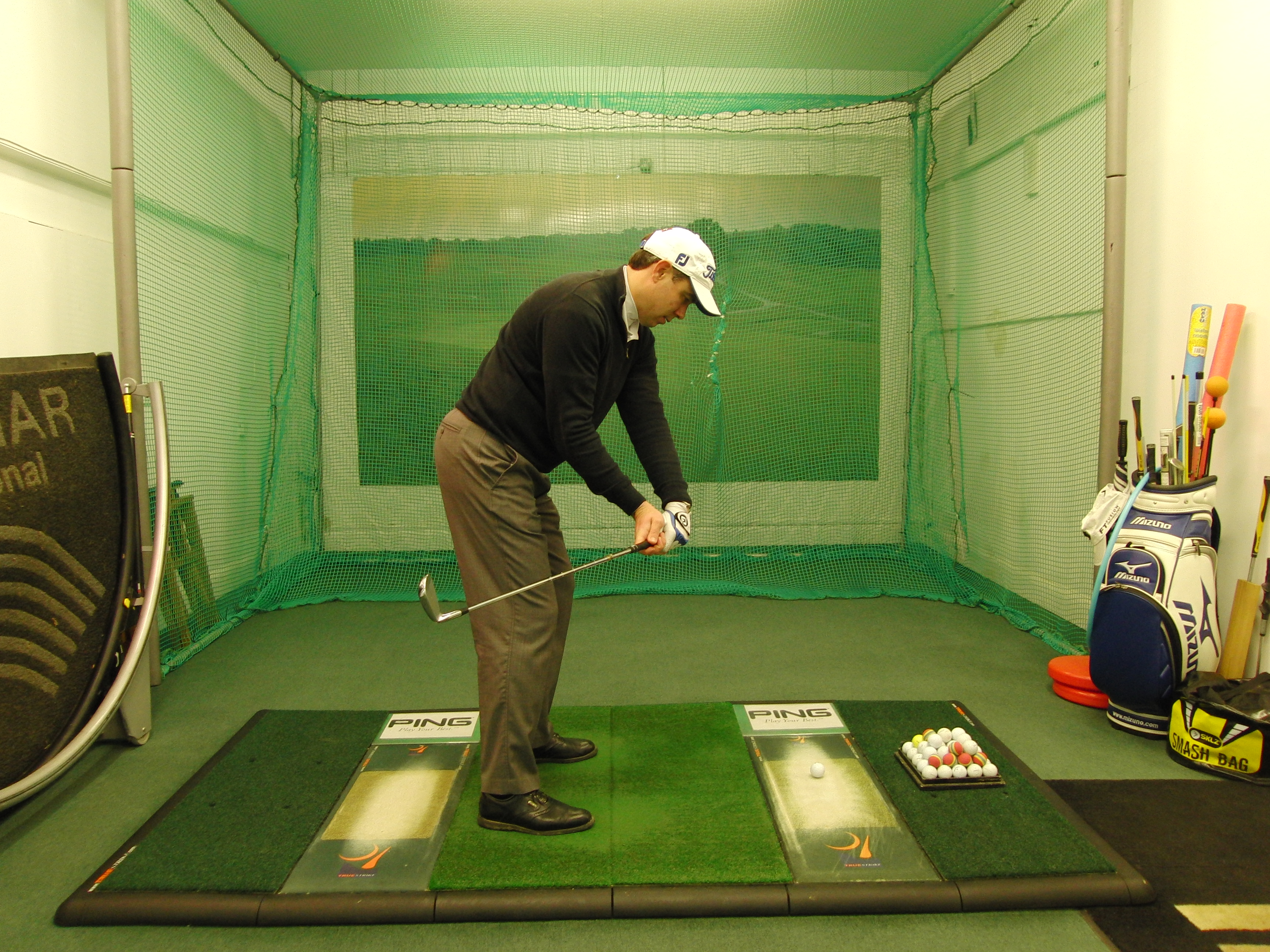
Bad takeaway where the right wrist has hinged back too
much on itself.

Bad takeaway where the left arm has rotated too much in
the takeaway separating from the chest.
Drills to practise to get the takeaway right every time.
Headcover under the left arm drill
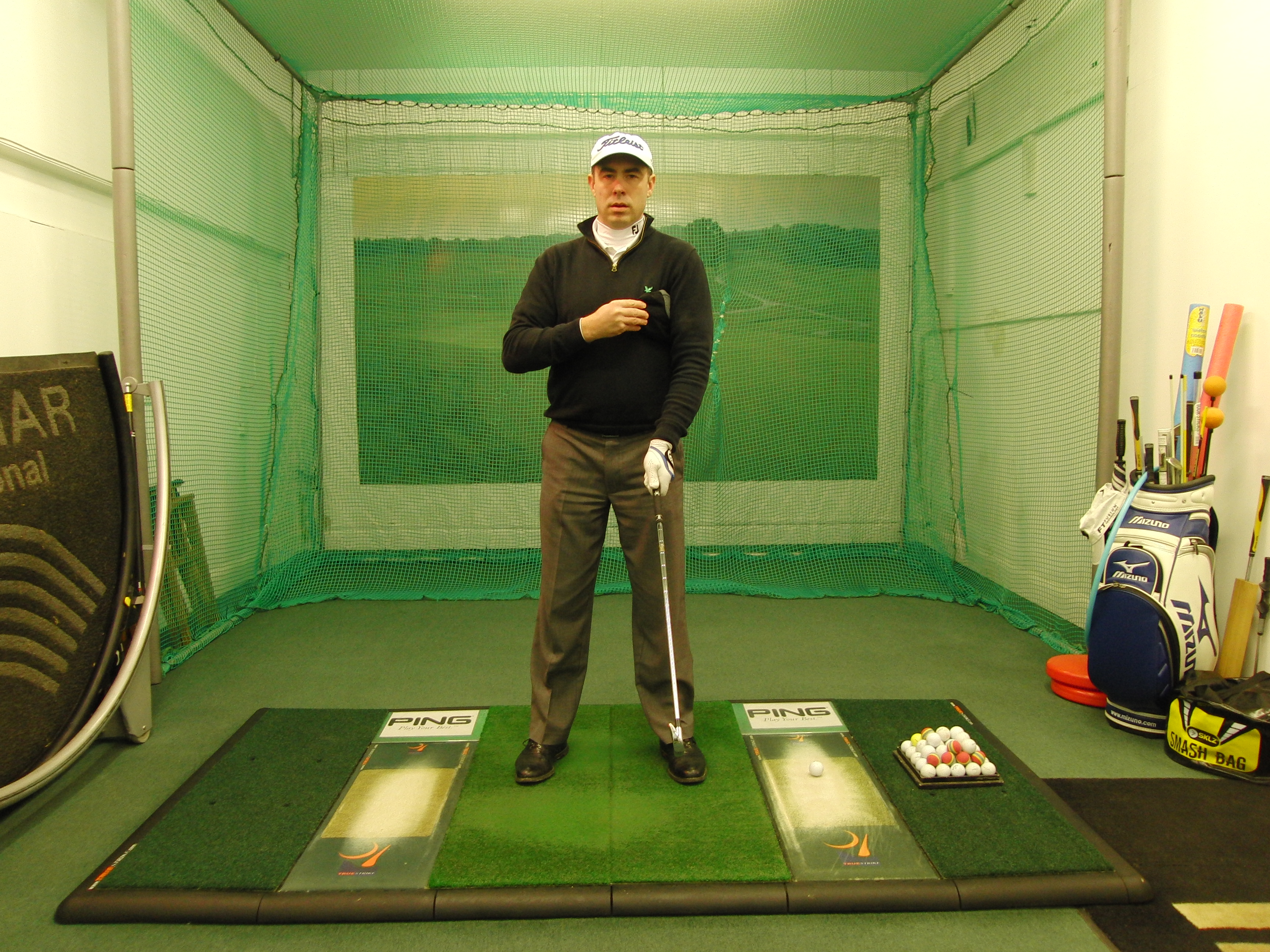
Place a headcover or glove under your left arm.
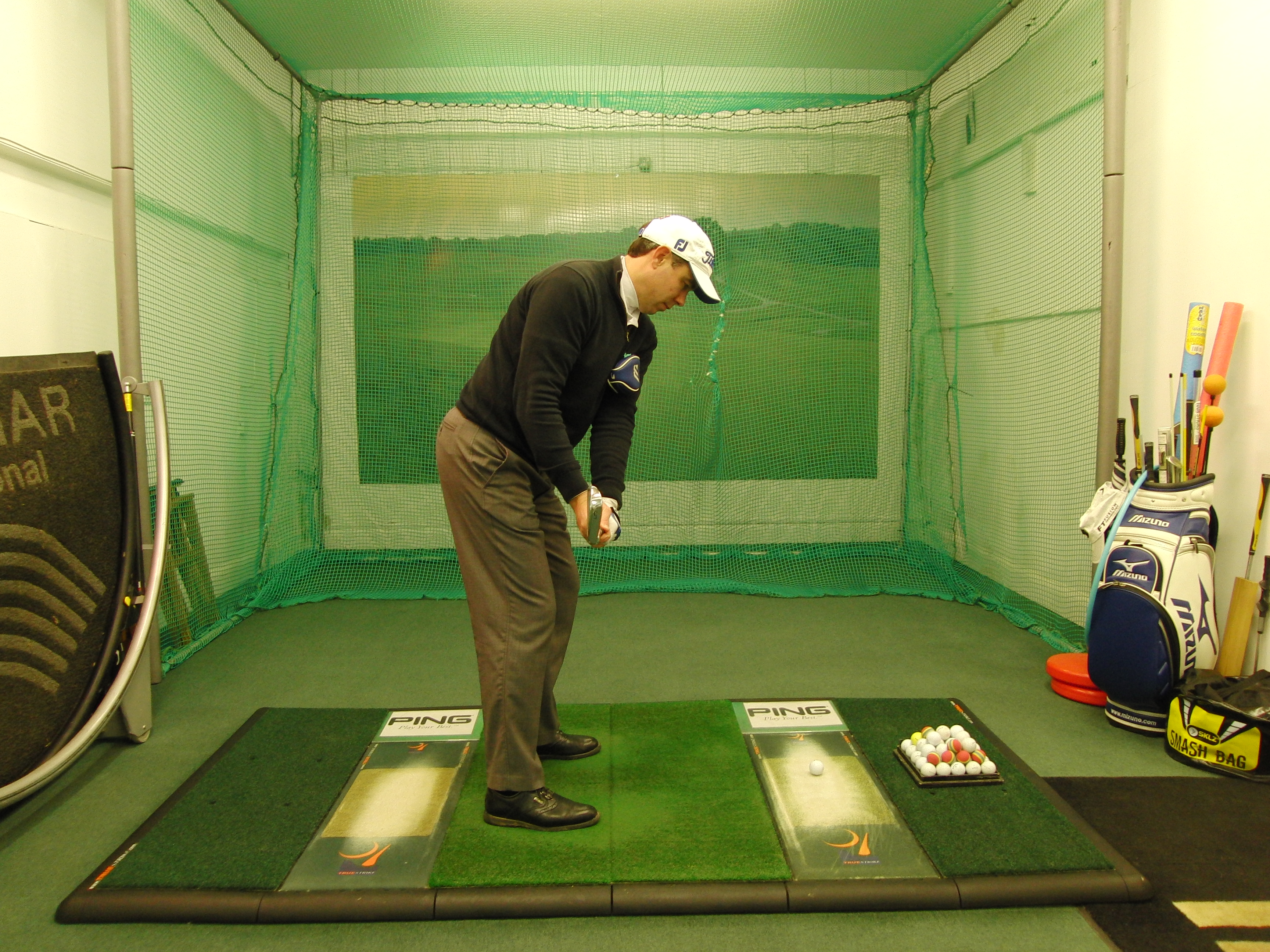
Make some swings back so that the shaft gets back parallel to
the ground this will keep you “connected” and as one unit.
Clubhead covering the hands.
Golf Ball Drill
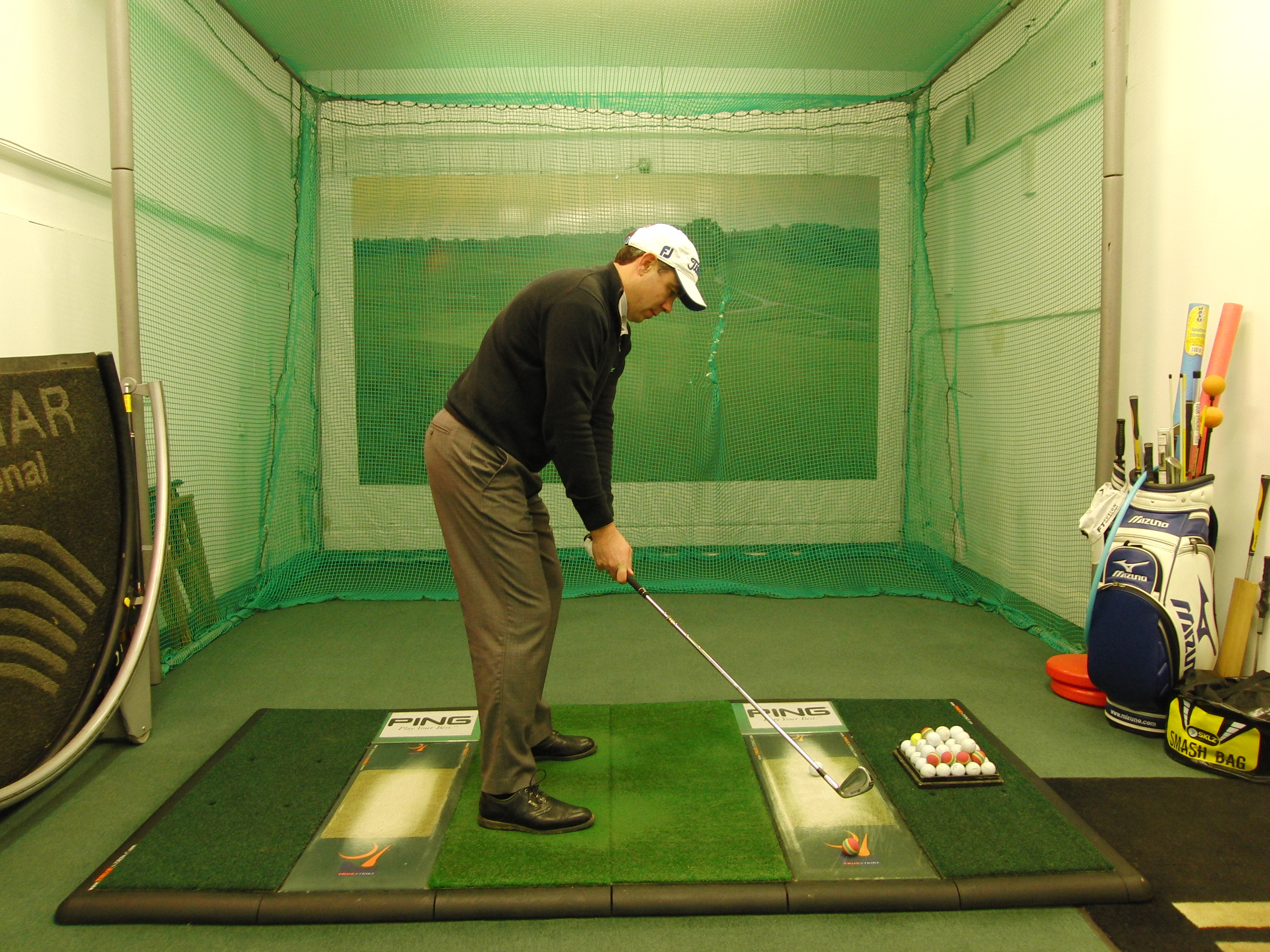
To stop the right wrist from hinging back on itself so early place a ball down 18 inches directly behind the ball you are going to strike. From here practise keeping the clubhead moving directly over the behind ball.
From Your Friends at Mark Wood Golf Academy
PS. Come down and tee it up to make some magic moments of your own. Check our website at
Mark Wood
PGA Advanced Professional
UK’s No1 Golf Coach
The Best Golf Lessons in Sussex and Kent
Happy Birthday Jack
“The summer I was 12, I broke 80 for the first time. It was odd how it happened. I shot 80 eight straight times, and just as I was wondering what I had to do to break that barrier, I shot 74.”
Jack Nicklaus
Even the great Jack Nicklaus scored in the 80s at one time; of course, he was only 11 years old! In his book, “The Greatest Game of All,” Jack describes breaking his own mental barrier when he beat “old man par”, as Bobby Jones called it, for the first time in his life.
The following year, Jack was playing golf with his father one evening when he shot 34 on the front nine, putting him in an excellent position to break 70 for the first time. To his dismay, as they walked off the 9th green his father congratulated him on a great nine holes and announced it was time to go home for dinner!
The young Nicklaus protested, but to no avail. His father said Ma was expecting them and they could finish the round after dinner. Both of them ate their food as quickly as they could swallow it and headed back to the course. Playing the par five 18th hole in near darkness, Nicklaus hit a long straight drive. He followed that with a 2-iron to the middle of the green, some 30 feet from the hole, just as the sprinklers came on. Making the eagle putt would give him a 69, and Jack Nicklaus seldom missed a putt that meant a lot to him. As he would do again and again during his unparalleled career when it really mattered, he rolled it in. To quote Jack, “The promised land!”
By regularly putting themselves in a position to win, overcoming fear of failure and being ready to accept success, champions dramatically increase their chances of victory. Once that first winner’s trophy is in the display case, others almost inevitably follow.
From Your Friends at Mark Wood Golf Academy
PS. Come down and tee it up to make some magic moments of your own. Check our website at
Mark Wood
PGA Advanced Professional
UK’s No1 Golf Coach
The Best Golf Lessons in Sussex and Kent
Wedges
Gene Sarazen Wedges
Before Gene Sarazen invented the sand wedge, most golfers played recovery shots from sand with a 9-iron. Because the blade was so sharp this required enormous skill, leaving little or no margin of error for any but the most talented player. Sarazen came up with his idea for a sand wedge while he was a passenger on an airplane one day. He noticed how the wing flaps affected the flight of the ’plane when they were extended. When the aircraft landed, he called the Wilson sporting goods company and asked them to send him six niblicks (9-irons). Then he went to the local hardware store and bought all the solder they had in stock. For the next few days Sarazen spent all his waking hours experimenting with the 9-irons by adding mass in different shapes and amounts to the sole of the club. He realized immediately he was on to something and he kept on soldering and filing and trying again until he got it right. The result was the world’s first true sand wedge and, so far as bunker play was concerned, a greatly improved Gene Sarazen.
From Your Friends at Mark Wood Golf Academy
PS. Come down and tee it up to make some magic moments of your own. Check our website at
Mark Wood
PGA Advanced Professional
UK’s No1 Golf Coach
The Best Golf Lessons in Sussex and Kent
Bizarre Golfing Injuries
Golfers and their Bizarre Injuries
We have all had little injuries that have stopped us from doing our most favorite sport, I once cut my hand on an open tin of beans which put me out of action for a few days!!
Here are some of the famous golfers and their bizarre injuries which have temporarily stopped them from competing.
Oliver Wilson – needed to take 6 weeks off after breaking his wrist as he tried to avoid a snowball during a snowball fight!!
Sam Torrance – In 1993 while at the Belfry, Sam cracked his sternum after he tripped over a plant pot while sleepwalking!!
David Feherty – A poisonous adder get the better of the Northern Irishman and put him in hospital during a round at Wentworth in 1992.
Graeme McDowell – G-Mac could not play at the WGC – HSBC Champions event after he badly hurt his hand on his hotel room door.
Ernie Els – Big Ernie was enjoying a family vacation in 2005 and after a banana boat ride went wrong he ruptured his anterior cruciate and put him out of action for 5 months during the 2005 season.
What injuries have you had, post them below……..
Mark Wood
PGA Advanced Professional
UK’s No1 Golf Coach
The Best Golf Lessons in Sussex and Kent
A Christmas Story
Christmas Story You’ll Love to Share!
A man named Bob May, depressed and brokenhearted, stared out his drafty apartment window into the chilling December night. His 4-year-old daughter Barbara sat on his lap quietly sobbing. Bobs wife, Evelyn, was dying of cancer.
Little Barbara couldn’t understand why her mommy could never come home. Barbara looked up into her dad’s eyes and asked, “Why isn’t Mommy just like everybody else’s Mommy?” Bob’s jaw tightened and his eyes welled with tears.
Her question brought waves of grief, but also of anger. It had been the story of Bob’s life. Life always had to be different for Bob.
Small when he was a kid, Bob was often bullied by other boys. He was too little at the time to compete in sports. He was often called names he’d rather not remember. From childhood, Bob was different and never seemed to fit in. Bob did complete college, married his loving wife and was grateful to get his job as a copywriter at Montgomery Ward during the Great Depression. Then he was blessed with his little girl. But it was all short-lived. Evelyn’s bout with cancer stripped them of all their savings and now Bob and his daughter were forced to live in a two-room apartment in he Chicago slums. Evelyn died just days before Christmas in 1938.
Bob struggled to give hope to his child, for whom he couldn’t even afford to buy a Christmas gift. But if he couldn’t buy a gift, he was determined a make one – a storybook! Bob had created a character in his own mind and told the animal’s story to little Barbara to give her comfort and hope. Again and again Bob told the story, embellishing it more with each telling. Who was the character? What was the story all about? The story Bob May created was his own autobiography in fable form. The character he created was a misfit outcast like he was. The name of the character? A little reindeer named Rudolph, with a big shiny nose. Bob finished the book just in time to give it to his little girl on Christmas Day. But the story doesn’t end there.
The general manager of Montgomery Ward caught wind of the little storybook and offered Bob May a nominal fee to purchase the rights to print the book. Wards went on to print,_ Rudolph the Red-Nosed Reindeer_ and distribute it to children visiting Santa Claus in their stores. By 1946 Wards had printed and distributed more than six million copies of Rudolph. That same year, a major publisher wanted to purchase the rights from Wards to print an updated version of the book.
In an unprecedented gesture of kindness, the CEO of Wards returned all rights back to Bob May. The book became a best seller. Many toy and marketing deals followed and Bob May, now remarried with a growing family, became wealthy from the story he created to comfort his grieving daughter. But the story doesn’t end there either.
Bob’s brother-in-law, Johnny Marks, made a song adaptation to Rudolph. Though the song was turned down by such popular vocalists as Bing Crosby and Dinah Shore , it was recorded by the singing cowboy, Gene Autry. “Rudolph the Red-Nosed Reindeer” was released in 1949 and became a phenomenal success, selling more records than any other Christmas song, with the exception of “White Christmas.”
The gift of love that Bob May created for his daughter so long ago kept on returning back to bless him again and again. And Bob May learned the lesson, just like his dear friend Rudolph, that being different isn’t so bad. In fact, being different can be a blessing.
Happy Christmas and a Wonderful New Year!
From Your Friends at Mark Wood Golf Academy
PS. Come down and tee it up to make some magic moments of your own. Check our website at
Mark Wood
PGA Advanced Professional
UK’s No1 Golf Coach
The Best Golf Lessons in Sussex and Kent
PITCH WITH YOUR BODY
PITCH WITH YOUR BODY
The best short game players in the world all have the same things in common, soft hands, great instincts and a good understanding that short shots are quite simply miniature full swings. The fundamentals that must apply in good pitching are keeping your weight slightly left, keeping the body turning towards the target through impact as well as keeping connected – upper and lower body in sync.
Poor pitchers of the golf ball are quite often out of sync during the downswing and through the ball, resulting in poor contact and poor distance control.
The normal things that happen to poor pitchers of the golf ball are –
- They freeze the upper body in the downswing leading to an overactive lower body.
- They don’t use there lower body and dominate the swing with the upper body
- Weight falls onto the back foot.
- Or they get handsy in their delivery of the club to the ball.
All of the above will make sure of one certain thing – poor contact and poor distance control.
When pitching try and keep the movement fluid and flowing, imagine some of your favourite golfer’s tempo’s and keep that in mind. This will help you keep everything synchronised and moving correctly. Feel as if you are using your big muscles – shoulders, chest, hips and especially the thighs to control the pitching motion.
Use the length of swing and loft of your wedges to regulate the distances – hip to hip swing, chest to chest swing and shoulder to shoulder swing. If you carry 3 wedges then you have 3 distances with each wedge, 9 in total.
From Your Friends at Mark Wood Golf Academy
PS. Come down and tee it up to make some magic moments of your own. Check our website at
Mark Wood
PGA Advanced Professional
UK’s No1 Golf Coach
The Best Golf Lessons in Sussex and Kent
Happy Birthday Christy
Christy O’Connor (born 21 December 1924) is a former Irish professional golfer
O’Connor was born in Knocknacarra, Galway. He turned professional in 1946. Throughout the 1960s he won at least one professional event during each year on the British Tour, a level of consistent success matched by very few other players. During his early career he was known simply as Christy O’Connor, but his nephew of the same name also became a prominent golfer, and since that time they have been referred to as Christy O’Connor Senior and Christy O’Connor Junior, respectively. He was affectionately known as “Himself” among his golfing peers.
O’Connor won the first £1,000 prize to be offered in British golf at the Swallow-Penfold Tournament held in 1955. O’Connor’s numerous tournament wins included the 1956 and 1959 British Masters. He also helped Ireland to win the Canada Cup in 1958 playing with Harry Bradshaw. He played in every Ryder Cup from 1955 to 1973, setting a record of ten appearances in the event which stood until it was surpassed by Nick Faldo in 1997. He was Irish professional champion on ten occasions, including in 1978 (when he was 53), and was twice (1961 and 1962) recipient of the Vardon Trophy for leading the British Tour’s Order of Merit. He tied for second place with Brian Huggett in the 1965 Open Championship, behind winner Peter Thomson.[1] In 1970 he won the John Player Classic, at that time its £25,000 first prize was the richest offered in golf (in those days, even the British Open champion received just a little over £5,000), it made him that season’s leading money-winner, although not Order of Merit leader, which was decided by a points system not directly related to prize money.
Later in his career, O’Connor became the leading “senior” player of his day, just before the lucrative U.S.-based Senior PGA Tour, now known as the Champions Tour, took off. He won the PGA Seniors Championship six times and the World Senior Championship in 1976 and 1977.
O’Connor was elected to the World Golf Hall of Fame in 2009 in the Veterans category.
Mark Wood
PGA Advanced Professional
UK’s No1 Golf Coach
The Best Golf Lessons in Sussex and Kent
Golf Lessons Sussex Golf Tips
PITCHING STANCE “SQUARE OR OPEN”
A way that pitching is still commonly taught is to stand way open with the ball deep back in your stance to promote a descending blow resulting in a ball turf strike.
If this is your way of pitching be careful as this will more often than not cause you to swing left down your body line, cutting across the ball promoting excessive side spin. I often find that golfers who pitch with the ball deep back in there stance will tend to favour the weight back too, resulting in a scooping action creating thin and very heavy shots.
“With the help of flightscope launch monitor and video we can now work closely with the player to get the maximum accuracy and control on these shots”
The modern approach to playing pitch shots is to stand square to the ball as this promotes many good qualities that good pitchers have –
- They use the bounce of the club so the leading edge does not dig in creating heavy shots.
- They stand square to the target line to promote a good swing path for greater accuracy.
- They play the ball forward in their stance to promote the correct angle of attack to maximise spin control.
- Their weight favors their target side and stays there throughout the shot creating the good ball turf bruising strike.
- They have a shallow angle of attack.
Ball forward in stance for a good angle of attack with the weight
on the left side.
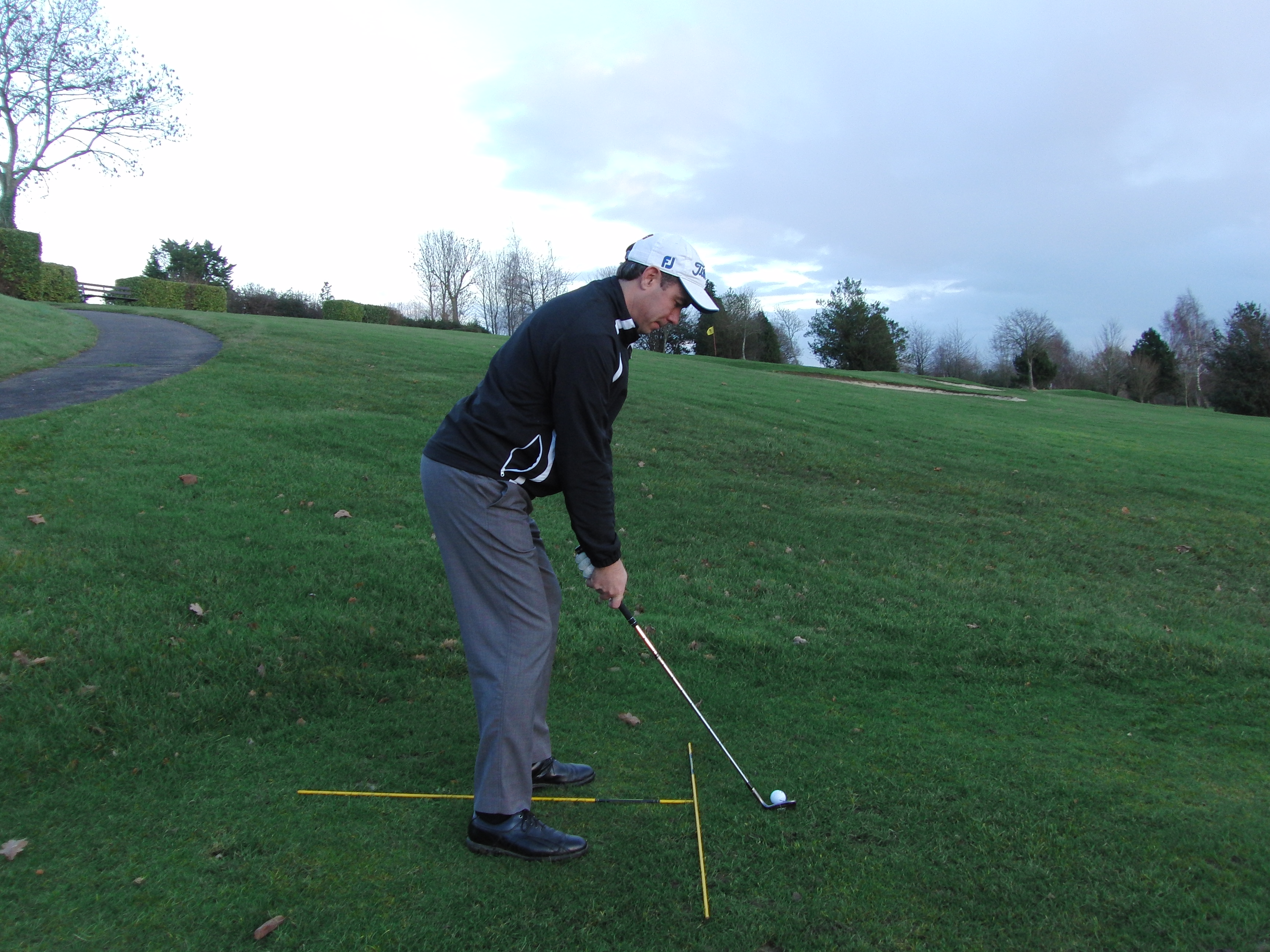
Body Alignment parallel to target line for a better swing path.
A great way to practise pitching is to put a work station down so you can practise more effectively from a good square set.
From Your Friends at Mark Wood Golf Academy
PS. Come down and tee it up to make some magic moments of your own. Check our website at
Mark Wood
PGA Advanced Professional
UK’s No1 Golf Coach
The Best Golf Lessons in Sussex and Kent
HOW TO FEEL A GREAT BACKSWING
HOW TO FEEL A GREAT BACKSWING
Being able to get into a good position at the top of your backswing is important as it gives you a better chance to make the correct downswing from the “inside”. A great drill to help you feel what a good top of the backswing position feels like is to do this simple exercise.
Take your normal regular set up to the ball, just as you would if you were about to hit it (photo 1).
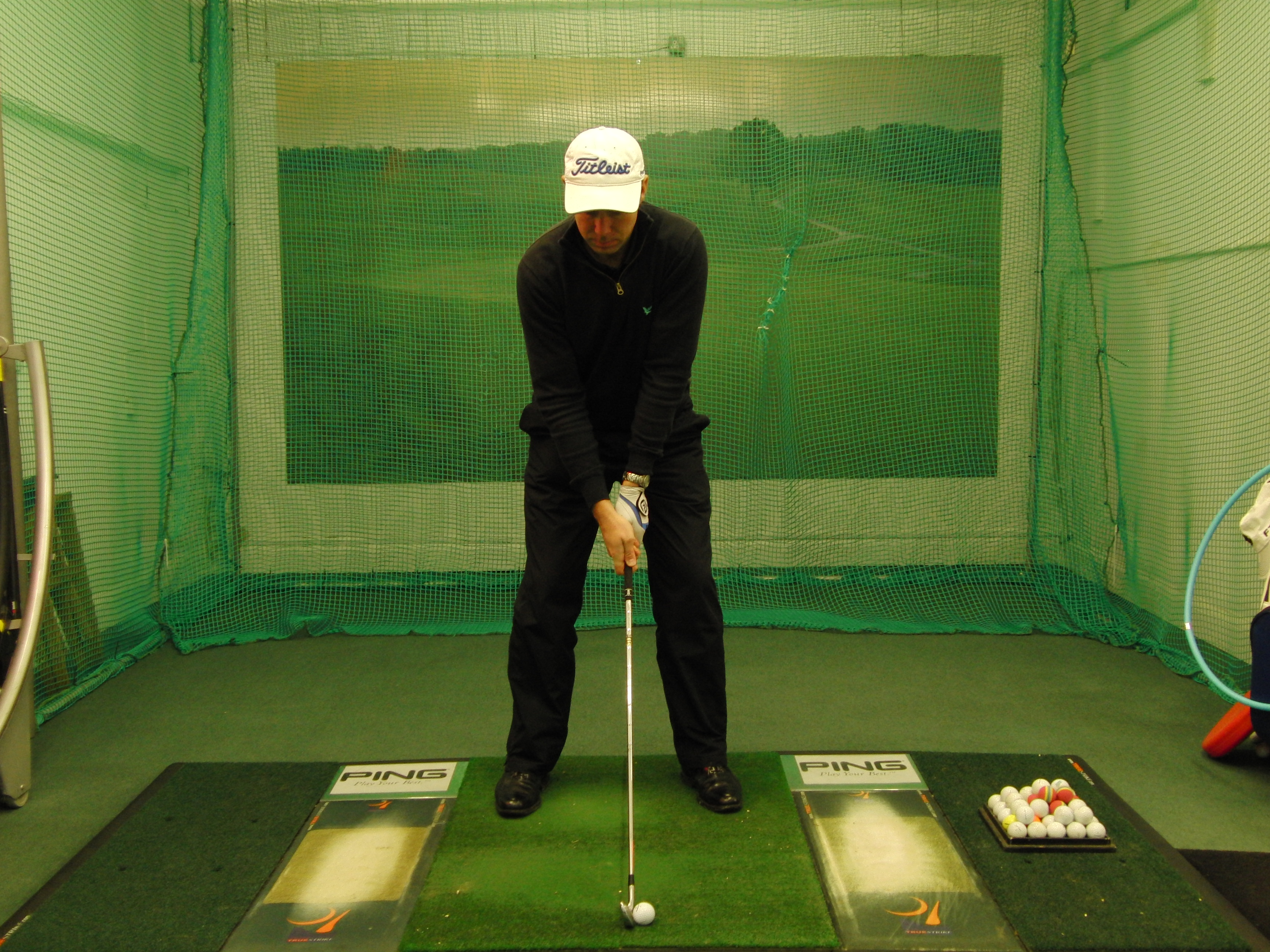
Then whilst you maintain your posture and body positions, lift the club up and rest it on your right shoulder next to your neck (photo 2). Your arms will be flexed at the elbow.

From here make a full shoulder and boy turn away from the target, just like you would do in a normal full backswing (photo 3).
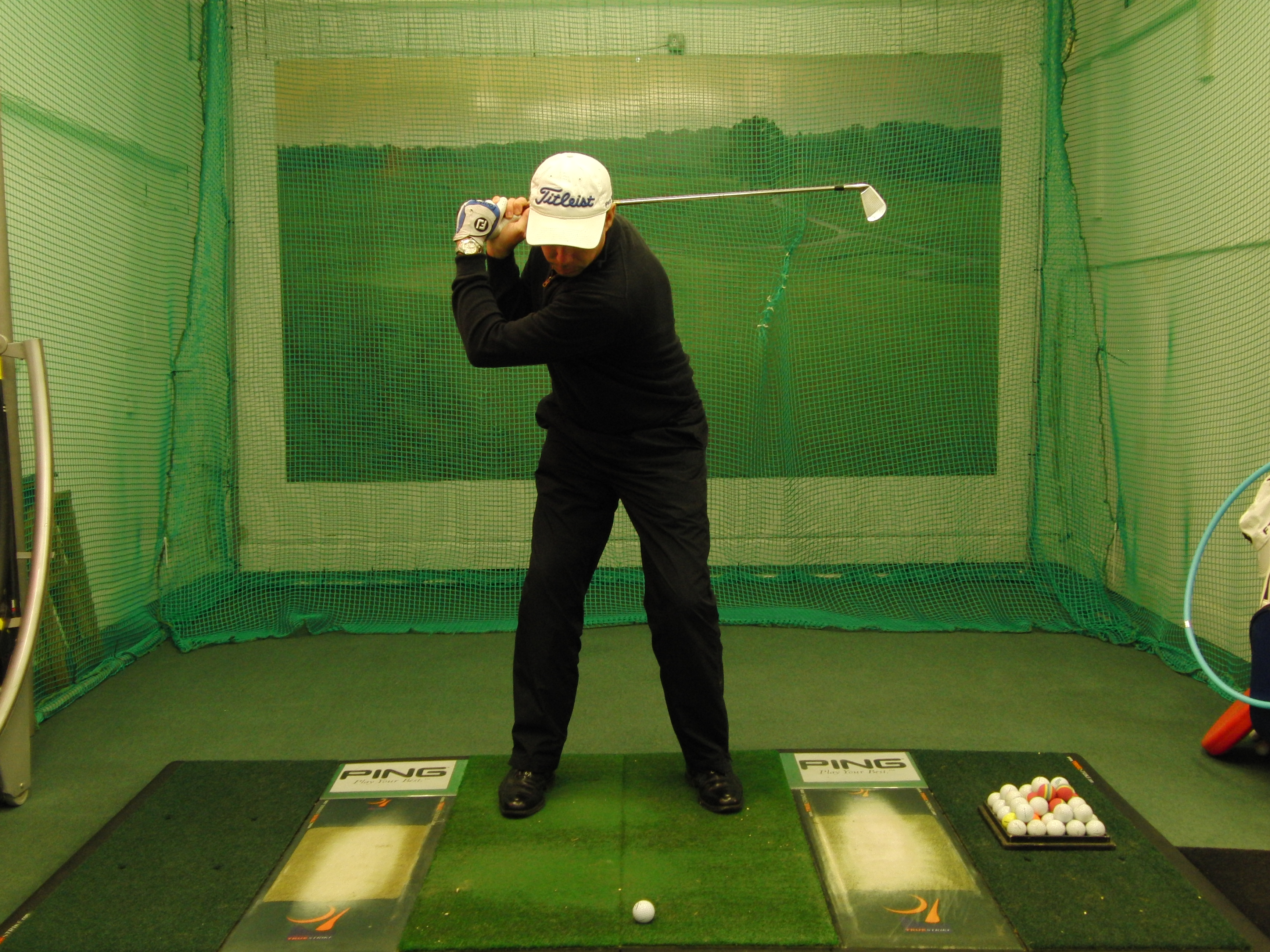
When you have completed your body turn extend your arms and hands up and away from your right ear until your left arm comfortably straightens (photo 4).
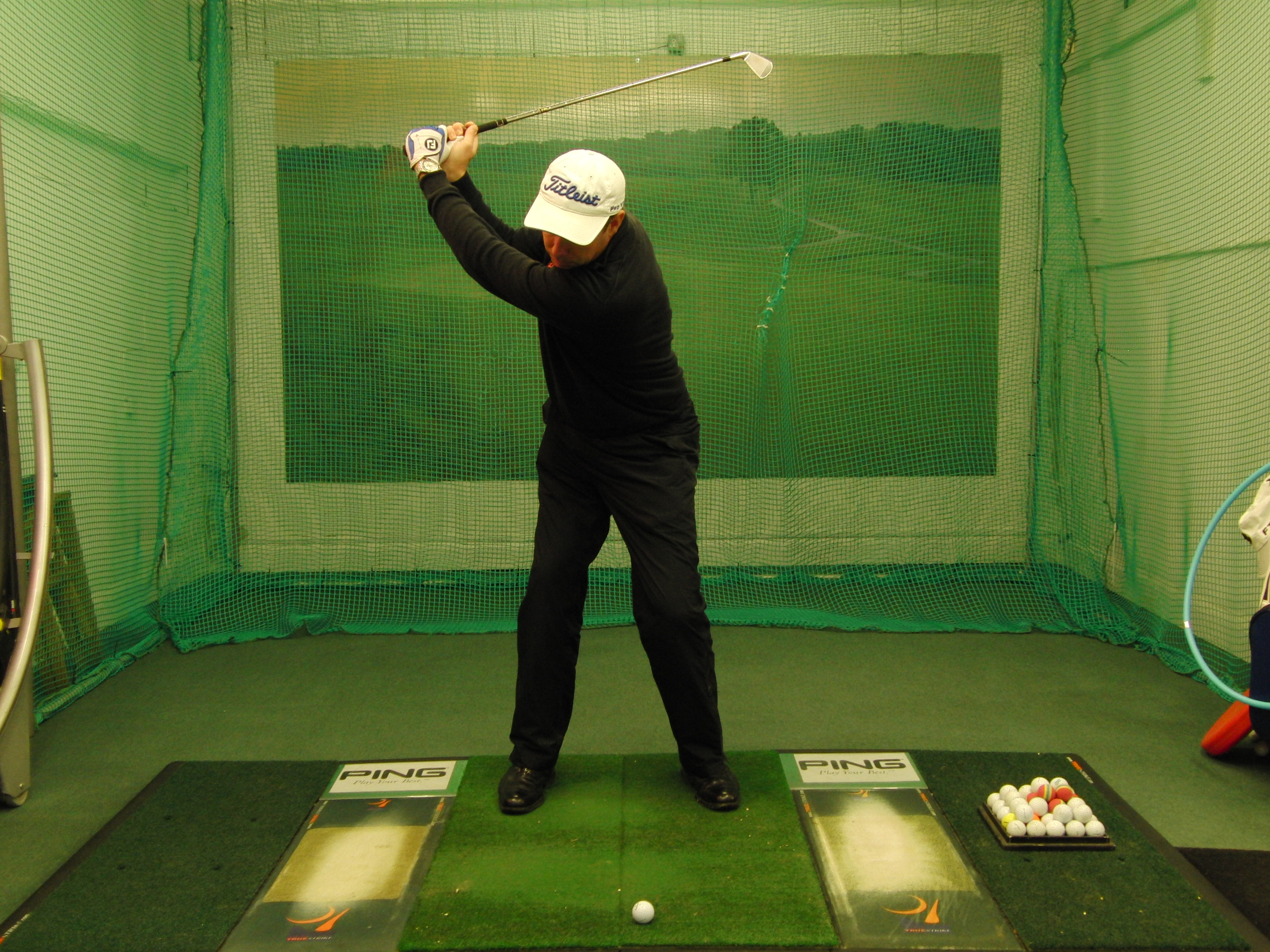
You are now feeling what a good position feels like at the top of the backswing. Practise this often, in front of a mirror, at the range and you can even hit balls like it.
It won’t take long for you to establish this as your normal go to position at the top of the backswing.
From Your Friends at Mark Wood Golf Academy
PS. Come down and tee it up to make some magic moments of your own. Check our website at
Mark Wood
PGA Advanced Professional
UK’s No1 Golf Coach
The Best Golf Lessons in Sussex and Kent





